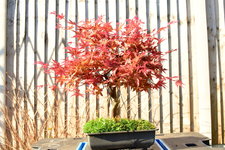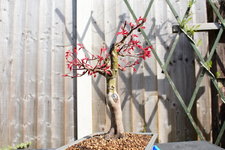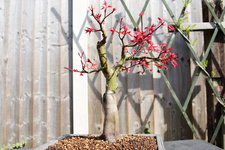A few additional thoughts - these are lower priority items, because I think you need to make some decisions about the trunk line before you start worrying about them, but I’ll offer them anyway as food for thought. The tree looks good in leaf as you’ve done a good job keeping the canopy in proportion. But a real challenge with deciduous trees is that they’re often shown without leaf and then all the flaws are obvious. You just can’t get away with some of the tricks that people use to create a nice looking canopy on a pine or juniper, because they use the foliage to hide them. So here are a few things to consider as you’re developing branch structure (remember - trunk, nebari, roots first and then worry about branches).
View attachment 309279
A) you have two primary branches coming out of the trunk at the same point. I think it will be OK in this case, but watch for swelling of the trunk at this point. You may have to reduce one.
B) Your wiring has improved, but watch the spacing. it’s easy to go from widely spaced loops to narrowly spaced. It’s not just a neatness thing - where the turns are determine where the bends in the branches are. So if you have widely spaced loops, you’ll have widely spaced bends and vice versa. Try and keep your angles the same and the loops uniform. And it looks neater.
C) It appears as though you might have three branches coming out of the same point. It already looks like there might be some swelling. Always reduce to two at any branch junction to avoid this. If it happens, it’s almost impossible to correct.
D) It looks like you‘ve introduced a strong bend at this point that’s out of character with the rest of the branch structure. I’m guessing that is to fill in a place on the outer canopy. This is a conifer trick - it will look weird when all the leaves are off. On deciduous trees, try to keep the bends softer and make sure that the branch structure make sense. You’re looking for branches that go upward and outward on deciduous trees. and they tend to move together. Take a look at some really good trees you admire - study Walter’s or Bill’s or some of the really good Japanese bonsai. There is a pattern to the branch structure - they tend to be lower angle further down on the trunk and sweep upward the closer to the apex you get. Branches near the top tend to be vertical. And all the branches work together - rarely will you see a bend like this. Try to keep to a pattern or it will look sloppy without leaves.
E) Spacing is good here and you did a good job keeping the wiring uniform. But the wire is not anchored. It will teeter-totter if you try to move these branches up and down.
F) Watch for obtuse angles like this at branch locations. Try to keep them acute.
G) Some of these internodes are pretty long - probably too long to be part of the final design of the tree. Let the tree grow out strongly at this stage. Keep the shoots with short internodes. Cut off the long ones because you won’t be able to use them as part of the final design. When the tree buds back and sends out a second flush, you’ll hopefully get a better shoot you can use.
H) Spacing is good here, but the wire is not anchored. As in E), the branch will teeter-totter if you try to move it up and down.
I) Watch out for straight sections like this without branches or movement. Remember, you build deciduous branches from the inside out. If you just let them grow out and then focus on development of the outer canopy, you’ll end up with long, straight branches with a poof of twiggy growth at the end. It won’t look good. Deciduous branches are made exactly the same way trunks are made. Let the grow out, then cut them back short. Then let them grow out again, and cut them back again. You repeat over and over focusing on the first inch, then the second, then the third, etc. You want good movement, taper and branching from close to the trunk all the way out to the branch tips.
Finally - when you’re building branches, focus on the leader first and then the secondary branches (the ones coming off the leader). When you get out to the tertiary and quaternary branches, you’re getting into twiggy growth and the leader thing becomes less important.
Anyway - those are my thoughts. Deciduous trees take time, but II think you have a nice tree with potential and you’ll learn a lot from working on it.
S

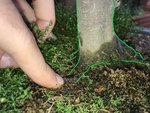
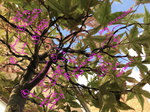

 DSC_2005
DSC_2005 DSC_2006
DSC_2006 DSC_1997
DSC_1997 DSC_2001
DSC_2001 DSC_2004
DSC_2004 DSC_2000
DSC_2000 DSC_2599
DSC_2599 DSC_2601
DSC_2601 DSC_2610
DSC_2610 DSC_2612
DSC_2612 DSC_2608
DSC_2608 DSC_2987
DSC_2987 DSC_2990
DSC_2990 DSC_2993
DSC_2993